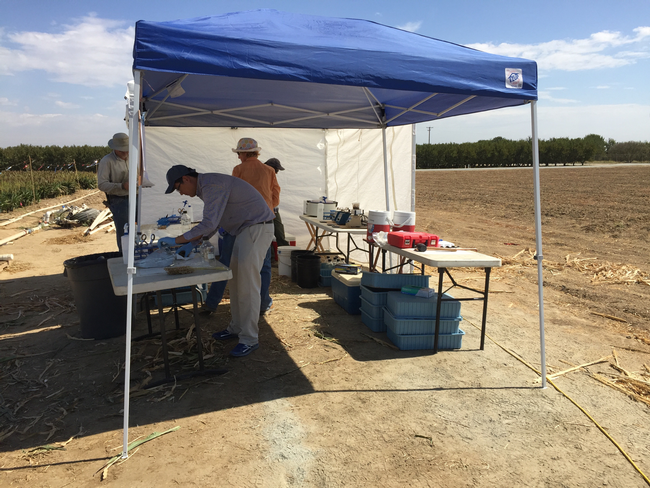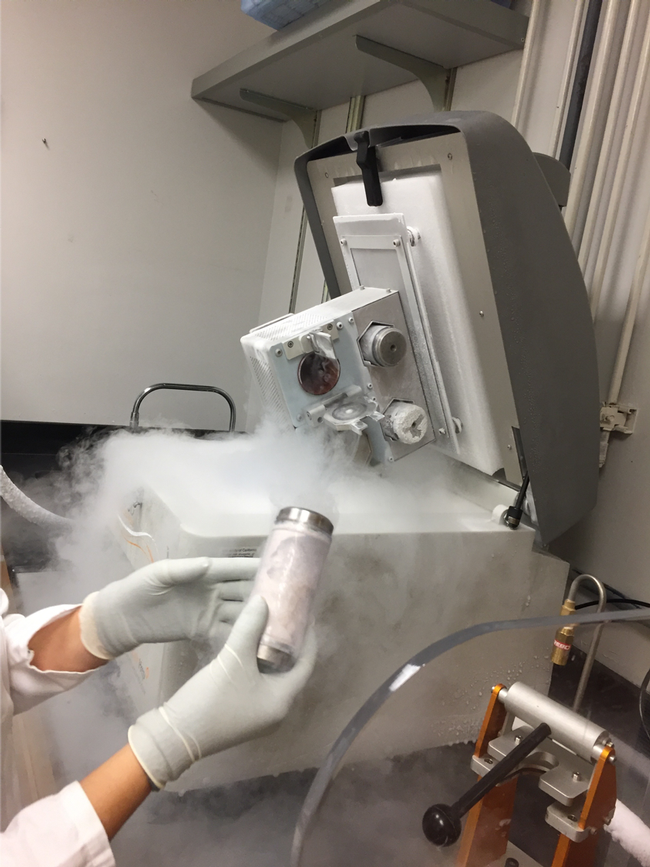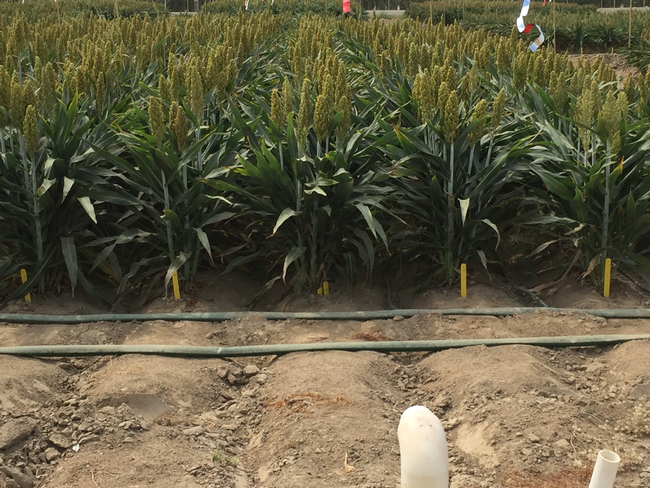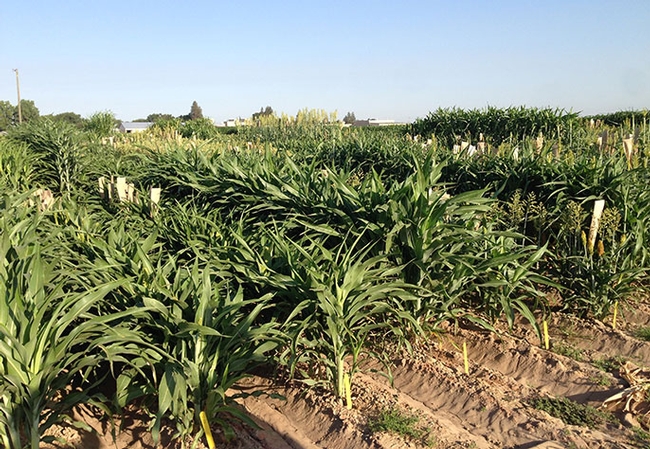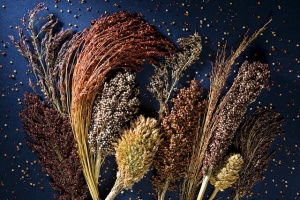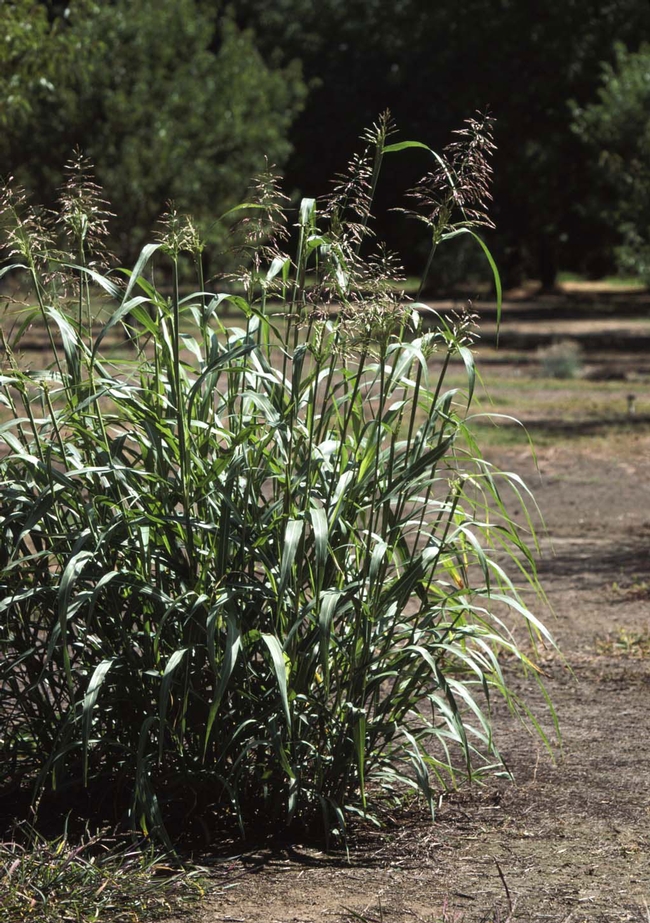Posts Tagged: sorghum
Genomic gymnastics help sorghum plant survive drought
Scorching temperatures and parched earth are no match for the sorghum plant — this cereal crop, native to Africa, will remain green and productive, even under conditions that would render other plants brown, brittle and barren.
A new study published this week in the journal Proceedings of the National Academy of Sciences provides the first detailed look at how the plant exercises exquisite control over its genome — switching some genes on and some genes off at the first sign of water scarcity, and again when water returns — to survive when its surroundings turn harsh and arid.
“With this research, we are laying the groundwork for understanding drought tolerance in cereal crops,” said Jeff Dahlberg, UC Cooperative Extension sorghum specialist. Dahlberg, co-author of the study, is also director the UC Kearney Agricultural Research and Extension Center in Parlier, one of nine research and extension centers in California that are part of UC Agriculture and Natural Resources.
Dahlberg said researchers can use the knowledge gained from this project to search for drought genes in other cereal crops.
“That has implications for feeding the world, particularly considering changing climate and weather patterns,” he said.
The massive dataset, collected from 400 samples of sorghum plants grown during 17 weeks at Kearney, reveals that the plant modulates the expression of a total of 10,727 genes, or more than 40% of its genome, in response to drought stress. Many of these changes occur within a week of the plant missing a weekly watering or after it is first watered after weeks of no precipitation or irrigation.
Kearney is a 330-acre agriculture research facility in the heart of California's Central Valley, where field-scale, real-world research can be conducted on drought impact on plants and soil microbial communities. The climate is naturally dry throughout the summer, making it ideal to mimic drought conditions by withholding irrigation water.
“People have really shied away from doing these types of experiments in the field and instead conduct them under controlled conditions in the laboratory or greenhouse. But I believe that the investment of time and resources that we put into it is going to pay off, in terms of the quality of the answers that we get, in terms of understanding real-world drought situations,” said Peggy Lemaux, UC Cooperative Extension specialist in UC Berkeley's Department of Plant and Microbial Biology and co-author of the paper.
To conduct the research, the team cultivated sorghum plants under three different irrigation conditions — pre-flowering drought, post-flowering drought and controlled applications of water — over three consecutive years at Kearney.
Each week during the growing season, members of the research team carefully harvested samples from the leaves and roots of selected plants and set up a mobile lab in the field where they could rapidly freeze the samples until they were processed for analysis. Then, researchers at JGI sequenced the RNA in each sample to create the transcriptome data, which reveals which of the plant's tens of thousands of genes are being transcribed and used to make proteins at particular times.
Finally, statisticians led by UC Berkeley statistics professor Elizabeth Purdom parsed the massive transcriptome data set to pinpoint how gene expression changed as the plants grew and were subjected to drought or relief from drought conditions.
“We very carefully controlled the watering conditions, and we sampled over the entire developmental timeframe of sorghum, so [researchers] could actually use this data not only to study drought stress, but also to study plant development,” Lemaux said.
The researchers noticed a few interesting patterns in the transcriptome data. First, they found that a set of genes known to help the plant foster symbiotic relationships with a type of fungus that lives around its roots was switched off in drought conditions. This set of genes exhibited the most dramatic changes in gene activity that they observed.
“That was interesting, because it hinted that the plants were turning off these associations [with fungi] when they were dry,” said John Vogel, a staff scientist at JGI and co-author of the paper. “That meshed well with findings that showed that the abundance of these fungi around the roots was decreasing at the same time.”
Second, they noticed that certain genes known to be involved with photosynthesis were also turned off in response to drought and turned up during drought recovery. While the team doesn't yet know why these changes might help the plant, they provide interesting clues for follow-up.
The data in the current paper show the plant's transcriptome under both normal conditions and drought conditions over the course of a single growing season. In the future, the team also plans to publish data from the other two years of the experiment, as well as proteomic and metabolomic data.
Nelle Varoquaux and Cheng Gao of UC Berkeley and Benjamin Cole of JGI are co-first-authors of the study. Other co-authors include Grady Pierroz, Christopher R. Baker, Dhruv Patel, Mary Madera, Tim Jeffers, Judith A. Owiti, Stephanie DeGraaf, Ling Xu, Krishna K. Niyogi, Devin Coleman-Derr and John W. Taylor of UC Berkeley; Joy Hollingsworth, Julie Sievert and Jeffery Dahlberg of UC ANR KARE; Yuko Yoshinaga, Vasanth R. Singan, Matthew J. Blow, Axel Visel and Ronan O'Malley of JGI; Maria J. Harrison of the Boyce Thompson Institute; Christer Jansson of PNNL and Robert Hutmacher of UC ANR.
This research was funded in part by the Department of Energy (DOE) grant DE-SC001408; the Gordon and Betty Moore Foundation grant GBMF3834; the Alfred P. Sloan Foundation grant
2013-10-27; L'Ecole NormaleSupérieure-Capital Fund Management data science chair and the DOE's Office of Biological and Environmental Research grant DE-SC0012460. Work conducted by the DOE JointGenome Institute is supported by the Office of Science of the DOE contractDE-AC02-05CH11231.
RELATED INFORMATION
- Dealing with Drought: Uncovering Sorghum's Secrets
- Berkeley to lead $12.3M study of crop drought tolerance
- Drought treatment restructures plants' microbiomes
- Microbes associated with plant roots could be a key to helping plants survive drought
UC research could help farmers face droughts worldwide
Sorghum is not only a potential drought-tolerant crop for the San Joaquin Valley, it also presents the opportunity for scientists to understand the mechanism behind drought tolerance at the genetic level, said UCCE sorghum specialist Jeff Dahlberg in a segment on ABC 30 Action News.
Reporter Cristina Davies spent an hour and a half at the UC Kearney Agricultural Research and Extension Center in Parlier during the sorghum harvest to learn about the potential of sorghum research.
"If we can elucidate the genetics behind (drought tolerance), what we believe is we can use those genetics to see if the genetics are available in corn, or in rice, or in wheat," Dahlberg said. "I think the genes may be there. We just don't have the tools yet to search for the genes in those crops."
Conducting drought-tolerance research in California is ideal because the summer is typically devoid of rain. Researchers can control exactly how much water is applied to each sorghum plot. The research has revealed more than 100 genetic markers that may confer drought tolerance.
"We've been really thrilled with the data that's been coming out of this. Like most research, we are learning so many things we don't understand," Dahlberg said.
The research is being conducted in collaboration with the USDA's Agricultural Research Service research center, which is across the street from Kearney. USDA research scientist Devin Coleman-Derr was present for the sorghum harvest.
"Like humans take probiotics, there may be a use for microbes in sort of promoting better and better yields in the field," Coleman-Derr said.
The 330-acre UC Kearney Agricultural Research and Extension Center is the University of California's largest off-campus agricultural research facility.
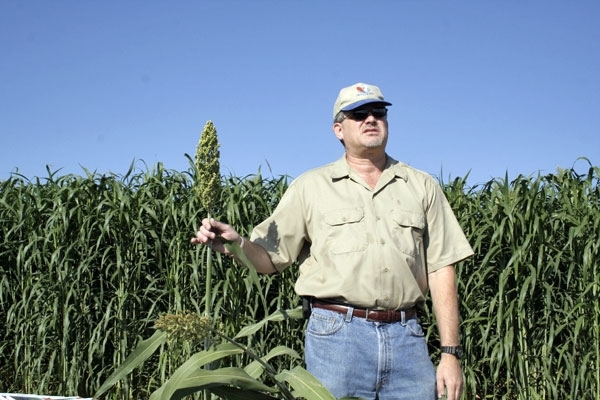
UCCE specialist Jeff Dahlberg studies sorghum at the UC Kearney Agricultural Research and Extension Center in Parlier.
Microbes associated with plant roots could be a key to helping plants survive drought
As sorghum plants cope with drought conditions, the plants' roots and adjoining microbial communities are communicating in a chemical language that appears to improve the plants' chances under water stress.
“It's amazing,” said Peggy Lemaux, UC Cooperative Extension specialist. “We know there are lots of microbes in the soil and, for the most part, ones in the surrounding soil stayed the same under drought conditions. We only saw changes in those microbes closely associated with the roots.”
The role of drought in restructuring the root microbiome was the first published discovery to come out of a sweeping drought research project underway since 2015 in the fields at UC Kearney Research and Extension Center in Parlier. The five-year study, funded with a $12.3 million grant from the Department of Energy, aims to tease out the genetics of drought tolerance in sorghum and its associated microbes. Using sorghum as a model, scientists hope the research will help them understand and improve drought tolerance in other crops as well.
The new research results from the lab of USDA's Devin Coleman-Derr at UC Berkeley, published April 16, 2018, in the Proceedings of the National Academy of Sciences, document the fate of microbes associated with sorghum roots under three distinct irrigation regimens. Because the San Joaquin Valley generally sees no rain during the growing season, it is the ideal place to mimic drought conditions by withholding irrigation water.
All plots received a pre-plant irrigation to initiate growth. In the control plots, sorghum was irrigated normally, with weekly watering through the season. In the plot simulating pre-flowering drought stress, the plants received no additional water until flowering, about halfway through the season. The third treatment was watered normally until it flowered, and then water was cut off for the rest of the season.
Beginning when the plants emerged, the scientists collected samples from each plot on the same day and time each week for 17 weeks. In a mini, in-field laboratory, roots, rhizosphere (zone surrounding the root), leaves and soil samples from 10 plants in each plot were immediately frozen and transported to Berkeley, where they were disseminated to collaborators, who investigated the plant and microbial responses at the molecular level.
“When a sorghum plant is subjected to drought, it starts sloughing off metabolites, nutrients and amino acids from the roots. The compounds appear to communicate to the neighboring microbial community that the plant is under stress,” Lemaux said. “That selects out a certain population of microbes. Certain types of microbes increase, others go away. When you add water back, the microbial community returns to its pre-drought population in just a few days.”
The researchers cultured two specific microbes that were enriched in the rootzone under drought conditions. They coated sorghum seeds with the microbes and planted them under drought conditions in a growth chamber. This treatment encouraged the plant to grow more roots.
“The microbes appear to improve plant growth during drought,” Lemaux said. “Those microbes appear to be helping plants survive drought. We didn't know that was happening before we got these results.”
Lemaux said the research might lead to future field use of the research breakthrough.
“A lot of companies are interested in the microbiome,” she said. “Some are already selling microbes to coat seeds.”
A spotlight on sorghum
Sorghum might just be one of the most interesting foods you aren't yet eating. This ancient cereal crop is the fifth most important cereal crop in the world, according to the Whole Grains Council. It's a popular food crop in Africa and parts of Asia, yet in the United States, sorghum has been more commonly used for feeding livestock. But that situation may be poised to change, as more chefs and farmers reconsider this ancient food, which is gluten-free, high-fiber and rich in nutrients.
Drought tolerant crop
To learn more about sorghum, we started with one of the nation's leading experts on the crop – Jeff Dahlberg, director of University of California's Kearney Agricultural Research Center in Parlier, CA. Jeff previously served as the USDA Agricultural Research Service (ARS) curator for sorghum. He was research director for the National Sorghum Producers and the United Sorghum Checkoff Program. In 2011, Jeff was recipient of National Sorghum Producers' Outstanding Achievement Award. In other words, he knows his sorghum.
The UC researcher tells us this ancient cereal crop can be grown on roughly 85 percent of the arable land available to agriculture.
“The versatility of sorghum allows it to be used in a wide range of food, feed and bioenergy products,” Dahlberg said. “The plant has inherent drought tolerance and can thrive in growing conditions that would seem too harsh for other crops. With more research and outreach, sorghum could be an extremely valuable crop for helping to feed the world in the future as we deal with limited inputs and water.”
Dahlberg first became interested in sorghum as a Peace Corps volunteer in Niger, a land-locked African country that consistently is one of the lowest-ranked in the United Nations' Human Development Index (HDI).
“Niger's farmers relied on rainfall to produce their major staples and sorghum was a crop that did well under limited rainfall,” Dahlberg said. “The crop was extremely versatile in that the grain was used for human food production, the leaves were harvested for animal feed and the stalks, many of which could be as tall as 12 feet, were used as building material. The versatility and the toughness of the crop got me interested in researching what made this crop work.”
For an interesting look at why farmers are considering sorghum, Dan Charles reports for NPR.
Delicious, nutritious food
What has Dahlberg most excited about sorghum is it's potential as a drought-tolerant human food crop.
“Sorghum has real potential as a healthy, low-cost cereal crop for the gluten-free market, but also as an Old World cereal that can be blended with other flours and used in unique breads," he said. “Sorghum doesn't have gluten, so you can't use it for nice leavened breads, but you can use sorghum to make nice biscuits, flat breads, quick breads, cakes, cookies, brownies and pancakes.
Sorghum should be thought of as whole grain flour that has a neutral color, little taste and unique cooking characteristics. Dahlberg admits his favorite way to eat this grain is as a brownie made with sorghum flour, but he says the plant “can be extruded to produce excellent snack and cereal products. It can be popped like popcorn, flaked and otherwise processed like other cereals.”
Recipes and nutrition
To find delicious ways to enjoy sorghum, we went in search of some good recipes.
These five ways to eat sorghum from thekitchn got us thinking. Why not use sorghum instead of rice for a change in salads? Also, the Mexican sorghum bowl looks delicious.
More fun serving ideas can be found at American Sorghum's page. Did you know there are now sorghum beers?
We also have our eye on this sorghum salad from Whole Grains Council; it includes oregano, feta cheese and pine nuts.
Sorghum syrup is an old-fashioned Southern favorite. As Sherry Leverich Tucker explains in this interesting Mother Earth News article, this sweet, dark, heavy syrup is made by cooking the juice squeezed from the sorghum cane. Just don't call it molasses, which is derived only from the process of making cane sugar. But do use sorghum as you would molasses in recipes. For ideas, consider these recipes from Southern Living. Beef ribs with sorghum glaze, anyone?
It's healthy: Medical Daily reports, “Sorghum has high nutritional value, with high levels of unsaturated fats, protein, fiber and minerals like phosphorus, potassium, calcium and iron. It also has more antioxidants than blueberries and pomegranates.”
In an old episode of the television show Cheers, the protagonist Sam Malone says, “I didn't say I wanted sorghum, I said I wanted some more gum.”
We think if Sam Malone had actually tried sorghum, he would have preferred it over gum.
Today's post is contributed by Teresa O'Connor, assistant editor of the UC Food Observer. The UC Food Observer is edited by ANR's Rose Hayden-Smith. For policy wonks to the public at large, the UC Food Observer is your daily selection of must-read news from the world of food and agriculture, developed by the University of California as part of the UC Global Food Initiative. The UC Food Observer blog and related social media channels aim to highlight important news and add value to the varied discussions occurring about how to sustainably and nutritiously feed the world. Follow us on Twitter and Facebook.
Invasive superweed Johnsongrass is the target of a new nationwide research effort
A team of researchers has received a $5 million grant from the U.S. Department of Agriculture to find new ways to combat Johnsongrass, one of the most widespread and troublesome agricultural weeds in the world.
“Johnsongrass is a huge problem,” said Jeff Dahlberg, UC Cooperative Extension sorghum specialist and director of the UC Kearney Agricultural Research and Extension Center in Parlier, Calif. “It impacts many different crops and is very hard to control.”
Dahlberg is part of the team that includes scientists from Virginia, Kansas, North Carolina, Texas and Georgia. Andrew Paterson, director of the Plant Genome Mapping Laboratory at the University of Georgia, Athens, is the lead investigator.
The naturalization of Johnsongrass across much of the U.S. has also allowed the plant to develop attributes — such as cold and drought tolerance, resistance to pathogens and the ability to flourish in low-fertility soils — that make it particularly difficult to control. Adding to the challenge is the adoption of herbicide-resistant crops around the world.
“Herbicide-resistant crops have been associated with a dramatic increase in herbicide-resistant weeds,” Patterson said. “With 21 genetically similar but different types of Johnsongrass known to be resistant to herbicides, it will only become more problematic in the future.”
Over the course of their five-year project, the researchers will work to better understand the weed's capabilities and the genes that make Johnsongrass so resilient. Johnsongrass [Sorghum halepense] is closely related to sorghum [Sorghum bicolor (L.) Moench], a healthy gluten-free grain, animal feed and biofuel crop. Lessons learned from the Johnsongrass research may lead to strategies to improve sorghum.
For his part, Dahlberg plans to use the global information system (GIS) to map the locations of Johnsongrass in California to better record its distribution in the state and to help understand how it spread into California by relating it to other populations of johnsongrass in the U.S.
“Ideally, we will use an app to map, identify, manage, and catalog populations that have developed different traits – such as susceptibility to plant disease, ability to host a particular insect, or resistance to herbicides,” he said.
This information may lead to new management strategies that target and curb its growth, providing farmers with more options to combat the invasive plant. The researchers also hope that learning more about the fundamental structures that give Johnsongrass its unusual resilience will pave the way for new genetic tools to improve useful plants, such as sorghum.
Other researchers working on this project are Jacob Barney, Virginia Tech; C. Michael Smith, Kansas State University; Wesley Everman, North Carolina State University; Marnie Rout, University of Texas, Temple; and Clint Magill and Gary Odvody, Texas A&M University.

